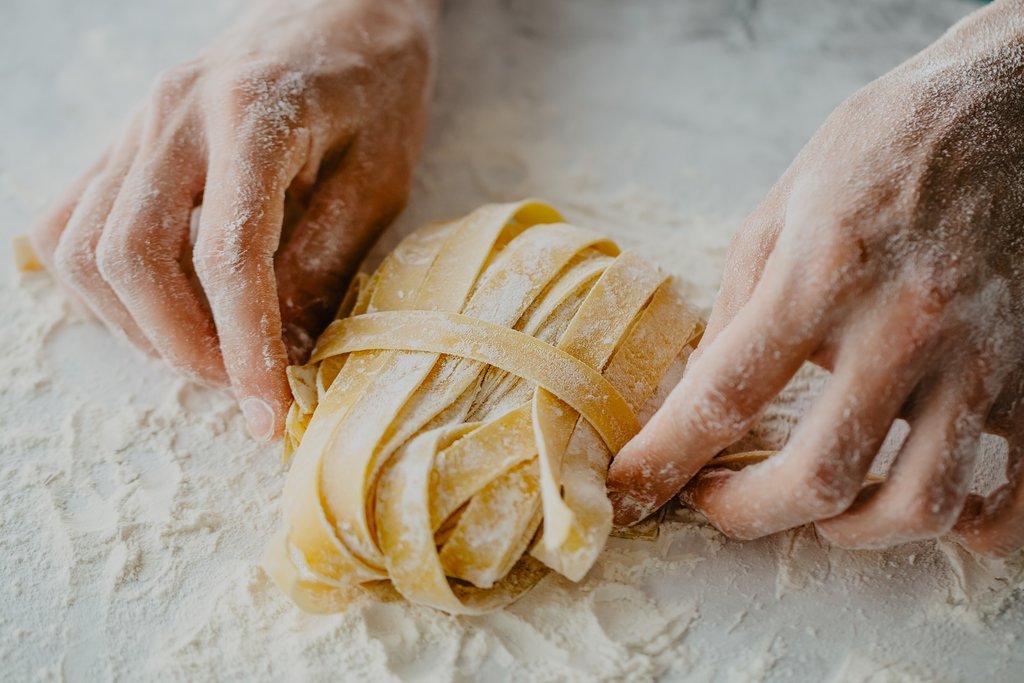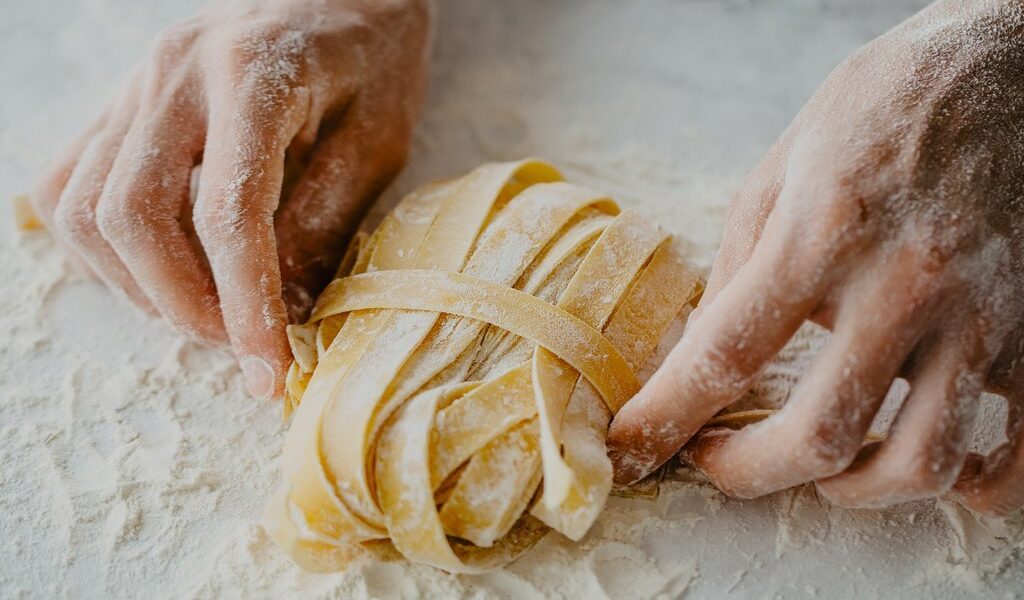
Eating in Italy goes way beyond the restaurant terrace. Factor in a first-hand experience to get closer to the source, be it tasting wafer-thin prosciutto on a food tour of Parma, a wine tour in the vine-clad Tuscan hills, or white truffle foraging in misty autumn woods of Alba in Piedmont. Dive in with our six favorite culinary experiences.
## Indulge in Italy’s Culinary Delights: A Gastronomic Journey
Italy, a land steeped in history, art, and culture, is equally renowned for its unparalleled culinary heritage. From the rolling hills of the north to the sun-drenched shores of the south, each region boasts unique flavors and time-honored traditions that tantalize the taste buds and leave a lasting impression. Embark on a gastronomic journey through Italy, exploring its diverse culinary landscape and uncovering the secrets behind its world-famous cuisine.
## Truffle Hunting in Piedmont: A Luxurious Foraging Experience
One of the most anticipated times of the year for Italians is undoubtedly truffle season. These elusive fungi, prized for their distinctively earthy, pungent flavor, add an exquisite touch to oils, sauces, and pasta dishes, captivating the senses and elevating any culinary creation. The Italians harbor a deep appreciation for truffles, recognizing their unique ability to transform simple ingredients into extraordinary gastronomic experiences.
While truffles can be found in various regions throughout the country, Piedmont, nestled in the far northwest of Italy, stands out as a particularly abundant source. Here, amidst the picturesque landscapes and rolling hills, you can embark on an unforgettable adventure, strapping on your hiking boots and venturing deep into the woods for a captivating couple of hours. Accompanied by a seasoned trifulau, a local truffle hunter, and a highly skilled dog, you’ll set out on a quest to unearth the hidden treasures of the forest: the coveted tartufo nero (black truffle) and the highly prized bianco (white truffle).
Imagine the thrill of witnessing the truffle dog’s keen sense of smell guide you through the dense foliage, leading you to the precise location of these hidden gems. As you carefully extract the truffles from the earth, you’ll gain a newfound appreciation for the intricate process and the expertise required to harvest these culinary treasures. Some truffle hunting trips offer the added bonus of returning to a traditional farm, where you can participate in the preparation of a delectable meal featuring the freshly unearthed truffles, savoring their exquisite flavor at its peak.
The white truffle harvest typically commences around mid-September, as the enchanting fall mists begin to blanket the region, and continues until December or January. Black truffles, on the other hand, are typically harvested from May to November, offering a longer window of opportunity to experience the thrill of the hunt. The undisputed highlight of the truffle hunting calendar is the renowned Fiera del Tartufo in Alba, held annually in October. This vibrant festival celebrates the prized and highly expensive tartufi bianchi (white truffles), which can command prices of hundreds of dollars apiece, reflecting their exceptional quality and rarity. During this festive time, most restaurants in Alba and the surrounding areas proudly feature truffles on their menus, allowing diners to indulge in the region’s most celebrated culinary offering.
## Unveiling the Secrets of Olive Oil in Puglia: A Liquid Gold Journey
Italy’s culinary landscape is also defined by its exceptional olive oil, a staple ingredient that elevates dishes with its rich flavor and health benefits. Competition among Italian regions is fierce, with each striving to produce the highest quality extra-virgin olive oil. The result is an array of pure, cold-pressed, golden-green oils, each possessing a unique peppery flavor profile that reflects the region’s terroir. However, for a truly immersive experience into the world of olio d’oliva, Puglia, located at Italy’s heel, stands out as the ultimate destination.
This hot, arid region, blessed with abundant sunshine and fertile soil, produces more extra-virgin olive oil than any other in Italy, and the quality is simply unparalleled. As you traverse the landscape of Puglia, you’ll be captivated by the sight of endless silver-green olive groves, home to an astounding 60 million olive trees that yield the region’s highly prized oil. To fully appreciate the liquid gold of Puglia, embark on an olive oil tour along the scenic 87-mile Strada dell’Olio di Puglia (Puglia’s Olive Oil Road). This enchanting route winds its way through olive oil presses, charming medieval hamlets and villages, and welcoming farms that open their doors for tours, tastings, and sales.
Engage with local producers, learn about the traditional methods of olive oil extraction, and savor the distinct flavors of various olive oil varieties. Discover the nuances of each pressing, the influence of the olive varietals, and the passion that goes into producing this essential ingredient of Italian cuisine. As you explore the Strada dell’Olio di Puglia, you’ll gain a profound appreciation for the cultural significance of olive oil in Puglia, a region where it is not just a food but a way of life.
## Vineyard Tours & Wine Tasting: A Celebration of Terroir
Italy’s allure extends beyond its culinary delights to encompass its rich winemaking tradition. The country’s landscape is adorned with sloping vineyards, and the sound of popping corks is synonymous with the aperitivo hour, a beloved Italian ritual. The wines produced in Italy are as diverse, complex, and rich as the country itself, reflecting the unique terroir and winemaking philosophies of each region. The Italians are rightfully passionate about their wines, celebrating their history, craftsmanship, and the convivial spirit they embody.
While you can sample regional wines in enoteche (wine bars) throughout Italy, a guided tour offers a deeper understanding of their subtle nuances. These tours provide a seamless experience, transporting you from cantina (cellar) to cantina, allowing you to fully immerse yourself in the world of Italian wine. Many tours also include a hearty lunch, providing a delightful opportunity to pair regional wines with local delicacies.
Tuscany, with its rolling hills, charming wineries, and picturesque landscapes, is one of Italy’s most renowned wine regions. In Chianti, nestled between Florence and Siena, charming wineries open their doors for tastings of the ruby-red Chianti Classico, a quintessential Tuscan wine. The region is an idyllic setting for a wine tour, with winding lanes that meander past warm-stone farmhouses, lush vineyards, sprawling olive groves, and historic medieval hill towns.
Venturing further south, you’ll encounter robust, medium-bodied Montepulciano and bold, full-bodied Brunello di Montalcino reds, both celebrated for their distinct characteristics and regional expressions. For a unique perspective on wine tasting in Tuscany, consider cycling the Eroica, a historic cycling route that winds through some of the region’s most famous vineyards.
Other regions that deserve recognition for their exceptional wines include the mountainous Piedmont, renowned for its stunning and sophisticated Barolo reds, and the Veneto, celebrated for its zesty, peachy Soave whites, velvety Amarone reds from the Valpolicella, and effervescent Prosecco.
Sicily is rapidly emerging as one of Italy’s most exciting wine regions, with grapes thriving in the volcanic soils of Mt. Etna. Notable wines from Sicily include honeyed Marsala, a sweet dessert wine, and spicy, fruity Nero d’Avola, both showcasing the island’s unique terroir and winemaking innovation.
## Mastering the Art of Italian Cuisine: Pasta, Gelato, and Beyond
For those seeking a more hands-on culinary experience, Italy offers a plethora of cooking classes that allow you to roll up your sleeves and learn how to whip up your own Italian feast. These classes cater to all skill levels, offering options to prepare a single dish or an entire menu. Typically, classes last for approximately three hours and involve preparing an appetizer, entrée, and dessert, culminating in a delightful meal where you can savor the fruits of your labor.
Many classes are conducted in small groups, fostering a sense of camaraderie and allowing for personalized instruction. Some classes even begin with a visit to the local market, providing an opportunity to select fresh, seasonal ingredients and immerse yourself in the local culture. Cooking classes offer an excellent way to connect with fellow travelers, break up sightseeing, and gain a deeper understanding of Italian culinary traditions. Moreover, you’ll leave armed with recipes to recreate the flavors of Italy in your own kitchen.
The specific dishes you’ll learn to prepare will vary depending on the location of the class. In Venice, you might learn to make risotto or polenta, while in Bologna, you’ll master the art of classic tagliatelle al ragù, better known as spaghetti Bolognese. In Naples, you’ll discover the secrets of crafting authentic gelato, while in Piedmont and Umbria, you’ll delve into truffle-based delicacies. The Dolomites might offer a gnocchi-making class, Cinque Terre could reveal the secrets of pesto, and Rome could guide you in creating the perfect pizza.
## Savoring the Flavors of Emilia-Romagna: A Foodie’s Paradise
Even Italians, renowned for their discerning palates, are captivated by the culinary delights of Emilia-Romagna. This region is widely regarded as one of Italy’s hottest foodie destinations, boasting a rich culinary heritage and a dedication to quality ingredients. The capital, Bologna, is affectionately nicknamed La Grassa (“the fat one”) with good reason. This is the birthplace of tagliatelle al ragù, thick egg pasta ribbons served with a rich meaty sauce, a dish that embodies the region’s commitment to hearty, flavorful cuisine. Numerous restaurants in Bologna proudly serve up the real deal, allowing visitors to experience this iconic dish in its authentic form.
However, Bologna is just the tip of the iceberg when it comes to exploring the culinary treasures of Emilia-Romagna. To truly savor the region’s gastronomic offerings, consider embarking on a guided, multi-stop food trip that takes you further afield to Parma and Modena for behind-the-scenes tours, tastings, and opportunities to purchase edible souvenirs.
Parma is, of course, the birthplace of world-famous Parmigiano-Reggiano, the wonderfully crumbly, nutty, salty cheese we call Parmesan. A visit to a dairy reveals the meticulous process involved in making this PDO (Protected Designation of Origin) cheese, from separating the curds to brine washing and aging the enormous wheels in cellars for 12 to 36 months.
This experience can be seamlessly combined with a visit to a salumificio (cured meat producer) nestled in the hills, where you can witness the preparation of sweet, silken prosciutto di Parma (Parma ham). To complete your culinary journey, consider rounding out the day at one of Modena’s acetaia (vinegar producers), where age-old family traditions are still diligently practiced. Balsamic vinegar is unlike any other vinegar, aged for a minimum of 12 years. The longer it ages, the richer, darker, and more syrupy it becomes, transforming into a culinary masterpiece.
## Street Food in Sicily: A Symphony of Flavors
When it comes to street food, no region in Italy surpasses Sicily, a volcanic island down south that ignites the senses and awakens the appetite. Geographically closer to North Africa than to Rome, Sicily‘s culinary landscape reflects its diverse influences, with a rich and distinctive use of spices and exotic flavors.
In the backstreets of coastal cities like Palermo and Catania, you can indulge in a symphony of flavors without breaking the bank. Here, you can sample local favorites such as sfincione, a thick-crust Sicilian-style pizza topped with onions and caciocavallo cheese; saffron-infused arancini, stuffed rice balls coated with breadcrumbs; and savory panelle, chickpea flour fritters. To complete your street food adventure, treat yourself to a refreshingly fruity granita, a semi-frozen granular dessert that captures the essence of summer in a glass.
The Sicilians have embraced a snacking culture for centuries, likely due to the island’s warm climate, which encourages outdoor living. Wander through the bustling markets, discover a hidden street food stall, part with a couple of euro, and watch as the chef grills or deep fries your chosen treat right before your eyes. This is street food at its finest, a celebration of local flavors, traditions, and the vibrant spirit of Sicily.

